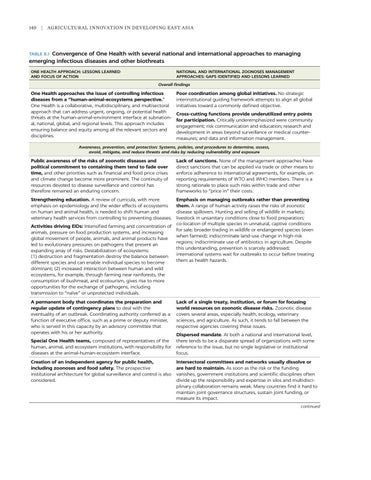140 | Agricultural Innovation in Developing East Asia
TABLE B.1 Convergence of One Health with several national and international approaches to managing emerging infectious diseases and other biothreats ONE HEALTH APPROACH: LESSONS LEARNED AND FOCUS OF ACTION
NATIONAL AND INTERNATIONAL ZOONOSES MANAGEMENT APPROACHES: GAPS IDENTIFIED AND LESSONS LEARNED Overall findings
One Health approaches the issue of controlling infectious diseases from a “human-animal-ecosystems perspective.” One Health is a collaborative, multidisciplinary, and multisectoral approach that can address urgent, ongoing, or potential health threats at the human-animal-environment interface at subnational, national, global, and regional levels. This approach includes ensuring balance and equity among all the relevant sectors and disciplines.
Poor coordination among global initiatives. No strategic interinstitutional guiding framework attempts to align all global initiatives toward a commonly defined objective. Cross-cutting functions provide underutilized entry points for participation. Critically underemphasized were community engagement; risk communication and education; research and development in areas beyond surveillance or medical countermeasures; and data and information management.
Awareness, prevention, and protection: Systems, policies, and procedures to determine, assess, avoid, mitigate, and reduce threats and risks by reducing vulnerability and exposure
Public awareness of the risks of zoonotic diseases and political commitment to containing them tend to fade over time, and other priorities such as financial and food price crises and climate change become more prominent. The continuity of resources devoted to disease surveillance and control has therefore remained an enduring concern.
Lack of sanctions. None of the management approaches have direct sanctions that can be applied via trade or other means to enforce adherence to international agreements, for example, on reporting requirements of WTO and WHO members. There is a strong rationale to place such risks within trade and other frameworks to “price in” their costs.
Strengthening education. A review of curricula, with more emphasis on epidemiology and the wider effects of ecosystems on human and animal health, is needed to shift human and veterinary health services from controlling to preventing diseases.
Emphasis on managing outbreaks rather than preventing them. A range of human activity raises the risks of zoonotic disease spillovers. Hunting and selling of wildlife in markets; livestock in unsanitary conditions close to food preparation; Activities driving EIDs: Intensified farming and concentration of co-location of multiple species in unnatural, captive conditions for sale; broader trading in wildlife or endangered species (even animals, pressure on food production systems, and increasing when farmed); indiscriminate land-use change in high-risk global movement of people, animals, and animal products have regions; indiscriminate use of antibiotics in agriculture. Despite led to evolutionary pressures on pathogens that present an this understanding, prevention is scarcely addressed; expanding array of risks. Destabilization of ecosystems: international systems wait for outbreaks to occur before treating (1) destruction and fragmentation destroy the balance between them as health hazards. different species and can enable individual species to become dominant; (2) increased interaction between human and wild ecosystems, for example, through farming near rainforests, the consumption of bushmeat, and ecotourism, gives rise to more opportunities for the exchange of pathogens, including transmission to “naïve” or unprotected individuals. A permanent body that coordinates the preparation and regular update of contingency plans to deal with the eventuality of an outbreak. Coordinating authority conferred as a function of executive office, such as a prime or deputy minister, who is served in this capacity by an advisory committee that operates with his or her authority. Special One Health teams, composed of representatives of the human, animal, and ecosystem institutions, with responsibility for diseases at the animal-human-ecosystem interface. Creation of an independent agency for public health, including zoonoses and food safety. The prospective institutional architecture for global surveillance and control is also considered.
Lack of a single treaty, institution, or forum for focusing world resources on zoonotic disease risks. Zoonotic disease covers several areas, especially health, ecology, veterinary sciences, and agriculture. As such, it tends to fall between the respective agencies covering these issues. Dispersed mandate. At both a national and international level, there tends to be a disparate spread of organizations with some reference to the issue, but no single legislative or institutional focus. Intersectoral committees and networks usually dissolve or are hard to maintain. As soon as the risk or the funding vanishes, government institutions and scientific disciplines often divide up the responsibility and expertise in silos and multidisciplinary collaboration remains weak. Many countries find it hard to maintain joint governance structures, sustain joint funding, or measure its impact. continued

